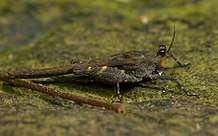Caelifera
| Caelifera | |
|---|---|
_cropped.jpg) | |
| A pygmy mole-cricket | |
 | |
| A groundhopper | |
| Scientific classification | |
| Kingdom: | Animalia |
| Clade: | Euarthropoda |
| Class: | Insecta |
| Order: | Orthoptera |
| Suborder: | Caelifera Ander, 1939 |
| Infraorders[2] | |
| |
The Caelifera[3] are a sub-order of Orthopteran insects. They include the grasshoppers and grasshopper-like insects, as well as other superfamilies classified with them: the ground-hoppers (Tetrigoidea) and pygmy mole crickets (Tridactyloidea). The latter should not be confused with the mole crickets (Gryllotalpidae), which belong to the other Orthopteran sub-order Ensifera.
Subdivisions and their distribution
The Caelifera includes some 2,400 valid genera and about 11,000 known species. Many undescribed species probably exist, especially in tropical forests. The Caelifera have a predominantly tropical distribution (as with most Orthoptera) with fewer species known from temperate climate zones. Caelifera are divided into two infraorders: the more basal Tridactylidea and the Acrididea or grasshopper-like species. This latter name is derived from older sources, such as Imms,[4] which placed the "short-horned grasshoppers" and locusts at the family level (Acrididae).
- Infraorder Tridactylidea
- Tridactyloidea Brullé, 1835: pygmy mole crickets[5] - all continents except Antarctica
- Dzhajloutshelloidea Gorochov, 1994 †
- Regiatoidea Gorochov, 1995 †
- Infraorder Acrididea[6] (superfamily group Acridomorpha includes all except superfamily Tetrigoidea)[7]
- Acridoidea MacLeay, 1821: most grasshoppers – World-wide - approx. 10,000 species in the Acrididae alone
- Eumastacoidea Burr, 1899: "monkey grasshoppers" - Americas, Africa, Australasia
- Locustopsoidea Handlirsch, 1906 †
- Pneumoroidea Blanchard, 1845: "bladder grasshoppers" - Africa
- Pyrgomorphoidea (monotypic) B. von Wattenwyl, 1882: "gaudy grasshoppers" - all tropical/subtropical continents
- Tanaoceroidea (monotypic) Rehn, 1948: "desert long-horned grasshoppers" - north America
- Tetrigoidea (monotypic) Serville, 1838: groundhoppers[5] or "grouse locusts"[4] - all continents except Antarctica
- Trigonopterygoidea Walker, 1870: "razor-backed bush-hoppers" - central America, south-east Asia
Affiliations
The phylogeny of the Caelifera, is described in detail for grasshoppers, with 6 out of 8 extant superfamilies shown here as a cladogram. Like the Ensifera, Caelifera and all of its superfamilies appear to be monophyletic.[3][8]
| Orthoptera |
| ||||||||||||||||||||||||||||||||||||||||||
Economic significance and terminology
A number of species, especially in the Acridoidea, are significant agricultural pests, but not all of them are locusts: a non-taxonomic term referring to species whose populations which may change morphologically when crowded and show swarming behaviour.[9] Examples of agricultural grasshopper pests that are not called locusts include the Senegalese grasshopper and certain species in the Pyrgomorphidae, notably the variegated grasshopper (Zonocerus variegatus).
References
- ↑ Zeuner, F. E. (1939). Fossil Orthoptera Ensifera. British Museum Natural History. OCLC 1514958.
- ↑ ITIS: Caelifera (retrieved 2 August 2017)
- 1 2 Rowell, Hugh; Flook, Paul (2001). "Caelifera: Shorthorned Grasshoppers, Locusts and Relatives". Tree of Life web project. Retrieved 20 July 2017.
- 1 2 Imms AD, rev. Richards OW & Davies RG (1970) A General Textbook of Entomology 9th Ed. Methuen 886 pp.
- 1 2 Ragge DR (1965). Grasshoppers, Crickets & Cockroaches of the British Isles. F Warne & Co, London. p. 299.
- ↑ ITIS: Acrididea (Retrieved 23/7/2017)
- ↑ Orthoptera Species File: infraorder Acrididea (Retrieved 20/7/2017)
- ↑ Flook, P. K.; Rowell, C. H. F. (1997). "The Phylogeny of the Caelifera (Insecta, Orthoptera) as Deduced from mtrRNA Gene Sequences". Molecular Phylogenetics and Evolution. 8 (1): 89–103. doi:10.1006/mpev.1997.0412. PMID 9242597.
- ↑ Uvarov BP (1966) Grasshoppers & Locusts. A Handbook of General Acridology Cambridge University Press, London 1:481 pp.
External links


- Tolweb: Caelifera
- Orthoptera Species File: Caelifera (accessed 20 July 2017)
- Palaeobiology database: Caelifera Ander 1936 (accessed 20 June 2017)
- ITIS: Caelifera (accessed 20 June 2017)
- NCBI: Caelifera (accessed 20 June 2017)